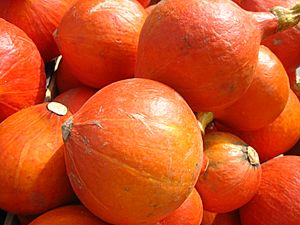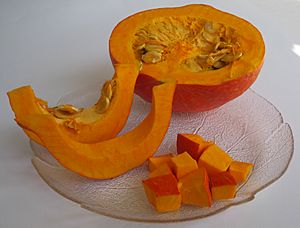Red kuri squash facts for kids
Red kuri squash is a bright orange winter squash with a thin skin. It looks a bit like a small pumpkin, but it doesn't have the deep ridges that pumpkins usually have. This squash is part of the Hubbard squash family.
Inside its hard outer skin, the firm orange flesh tastes a little like chestnuts, but very mild and sweet. Other squashes like 'Hokkaido' and 'Sweet Meat' are similar to Red Kuri.
Contents
Where Does Red Kuri Squash Come From?
Most people believe that all types of squash first grew in a region called Mesoamerica. This area includes parts of modern-day Mexico and Central America.
Red kuri squash has many different names around the world. It's often called "Japanese squash" or "orange Hokkaido squash." In Japan, the word kuri can mean this squash or a Japanese chestnut. In France, it's known as potimarron, and in the United Kingdom, people often call it "onion squash."
This squash is grown in many places, including Japan, parts of the United States (like California and Florida), Mexico, Tasmania, Tonga, New Zealand, Chile, Provence, and South Africa. It grows best in places that have at least 100 days of warm weather for it to grow. Much of the squash grown in California, Colorado, Tonga, and New Zealand is sent to Japan.
What Does Red Kuri Squash Look Like?
This tough squash grows well in sunny places and can handle dry weather. Each plant produces several teardrop-shaped fruits, usually three. The squash is ready to pick about 90 days after its flowers bloom.
Red kuri squash has a hard shell and firm yellow flesh inside. Sometimes, the flesh near the seeds can have a slight green color.
How to Cook Red Kuri Squash
Red kuri squash is full of flavor and naturally sweet. It's often cooked simply with butter and herbs. You can find it in many different dishes, like soups, stews, and casseroles.
Because of its nutty taste, it can also be used to make sweet treats such as cakes, muffins, cookies, jams, and pies. You can cook this squash in many ways: bake it, boil it, microwave it, steam it, sauté it, or even fry it. It adds a sweet taste and nice texture to stir-fries. The hollow space inside is also perfect for stuffing with other ingredients.
Nutrition Facts
Red kuri squash is a great source of fiber, which helps your body digest food. It also gives you lots of vitamin A and vitamin C, which are important for your health. You'll also find some B vitamins, calcium, potassium, iron, riboflavin, and thiamine in this colorful squash. It's low in calories and sodium, and it contains beta-carotene, which is what gives it its deep orange color.



